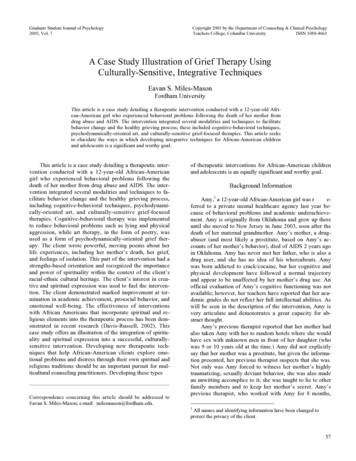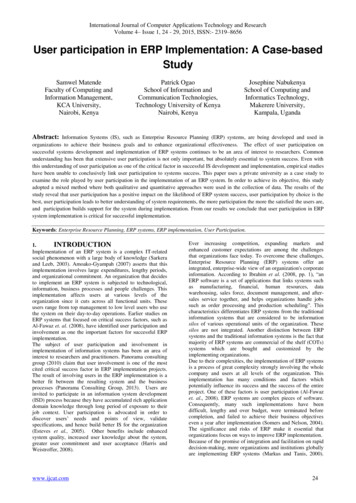
Transcription
Graduate Student Journal of Psychology2005, Vol. 7Copyright 2005 by the Department of Counseling & Clinical PsychologyTeachers College, Columbia UniversityISSN 1088-4661A Case Study Illustration of Grief Therapy UsingCulturally-Sensitive, Integrative TechniquesEavan S. Miles-MasonFordham UniversityThis article is a case study detailing a therapeutic intervention conducted with a 12-year-old African-American girl who experienced behavioral problems following the death of her mother fromdrug abuse and AIDS. The intervention integrated several modalities and techniques to facilitatebehavior change and the healthy grieving process; these included cognitive-behavioral techniques,psychodynamically-oriented art, and culturally-sensitive grief-focused therapies. This article seeksto elucidate the ways in which developing integrative techniques for African-American childrenand adolescents is a significant and worthy goal.This article is a case study detailing a therapeutic intervention conducted with a 12-year-old African-Americangirl who experienced behavioral problems following thedeath of her mother from drug abuse and AIDS. The intervention integrated several modalities and techniques to facilitate behavior change and the healthy grieving process,including cognitive-behavioral techniques, psychodynamically-oriented art, and culturally-sensitive grief-focusedtherapies. Cognitive-behavioral therapy was implementedto reduce behavioral problems such as lying and physicalaggression, while art therapy, in the form of poetry, wasused as a form of psychodynamically-oriented grief therapy. The client wrote powerful, moving poems about herlife experiences, including her mother’s death, her grief,and feelings of isolation. This part of the intervention had astrengths-based orientation and recognized the importanceand power of spirituality within the context of the client’sracial-ethnic cultural heritage. The client’s interest in creative and spiritual expression was used to fuel the intervention. The client demonstrated marked improvement at termination in academic achievement, prosocial behavior, andemotional well-being. The effectiveness of interventionswith African Americans that incorporate spiritual and religious elements into the therapeutic process has been demonstrated in recent research (Davis-Russell, 2002). Thiscase study offers an illustration of the integration of spirituality and spiritual expression into a successful, culturallysensitive intervention. Developing new therapeutic techniques that help African-American clients explore emotional problems and distress through their own spiritual andreligious traditions should be an important pursuit for multicultural counseling practitioners. Developing these typesCorrespondence concerning this article should be addressed toEavan S. Miles-Mason; e-mail: milesmason@fordham.edu.of therapeutic interventions for African-American childrenand adolescents is an equally significant and worthy goal.Background InformationAmy,1 a 12-year-old African-American girl was referred to a private mental healthcare agency last year because of behavioral problems and academic underachievement. Amy is originally from Oklahoma and grew up thereuntil she moved to New Jersey in June 2003, soon after thedeath of her maternal grandmother. Amy’s mother, a drugabuser (and most likely a prostitute, based on Amy’s accounts of her mother’s behavior), died of AIDS 2 years agoin Oklahoma. Amy has never met her father, who is also adrug user, and she has no idea of his whereabouts. Amywas born addicted to crack/cocaine, but her cognitive andphysical development have followed a normal trajectoryand appear to be unaffected by her mother’s drug use. Anofficial evaluation of Amy’s cognitive functioning was notavailable; however, her teachers have reported that her academic grades do not reflect her full intellectual abilities. Aswill be seen in the description of the intervention, Amy isvery articulate and demonstrates a great capacity for abstract thought.Amy’s previous therapist reported that her mother hadalso taken Amy with her to random hotels where she wouldhave sex with unknown men in front of her daughter (whowas 9 or 10 years old at the time.) Amy did not explicitlysay that her mother was a prostitute, but given the information presented, her previous therapist suspects that she was.Not only was Amy forced to witness her mother’s highlytraumatizing, sexually deviant behavior, she was also madean unwitting accomplice to it; she was taught to lie to otherfamily members and to keep her mother’s secret. Amy’sprevious therapist, who worked with Amy for 8 months,1All names and identifying information have been changed toprotect the privacy of the client.37
MILES-MASONsuspects that Amy may have been sexually abused due tosome of the behavior she has displayed at school and thehighly sexualized content of poems she was writing in therapy with him. Amy currently lives in New Jersey with heraunt who is a police officer. Amy and her aunt maintainclose familial relationships with members of their extendedfamily, who live in both New Jersey and Oklahoma.Amy’s current oppositional behavior is primarily lyingto her family and teachers in addition to exhibiting aggressive behavior towards some of her peers. Teachers atAmy’s school have reported that she has displayed “inappropriate,” sexually-suggestive behavior at school such asdancing provocatively and “grabbing at” boys in her class.(There have been no gross or serious instances of sexualassault or harassment.) Amy’s aunt, Annette who is employed as a police officer, is her primary caretaker. Her auntis a strict disciplinarian and often comes into conflict withAmy over her inappropriate behavior at school and continual lying. In spite of the tempestuous nature of their relationship, her aunt is solicitous of Amy’s welfare and, inAmy’s own words, “loves her,” even though she may not beoverly affectionate or demonstratively nurturing.When Amy’s previous therapist initially evaluated her,she was diagnosed with Adjustment Disorder with Anxiety.Amy’s grandmother had been the powerful matriarch oftheir extended family and provided stability and continualcare to Amy, as her mother was unreliable and often unableto function successfully. Until her death approximately oneyear after Amy’s mother’s death, Amy’s grandmother hadbeen Amy’s primary source of stability and love. Not onlywas she grieving for her mother’s and grandmother’sdeaths, but she was also forced to leave her home environment (where she had lived all her life) and relocate to aforeign one—New Jersey. Shortly after the move, Amybegan exhibiting oppositional behavior, primarily aggression towards other students and lying. Amy currently livesin a mostly white middle-class community and it has beendifficult for her to “fit in” with other students who have anentirely different cultural and socioeconomic background.In one of our initial sessions Amy expressed her feelings ofinferiority, saying that she was not “up to” the other students (e.g., she did not have the same amount of money,clothes, etc.) and that she was often taunted at school. Amydid not admit this to her aunt because she was embarrassedby it and said she was trying to be “tough,” not letting anyone (including her family) see that she was hurt by the otherstudents’ insults.I began working with Amy as a student intern in January 2004. After having two sessions with Amy, it was evident that she had not adjusted to her new environment andfelt like an outsider at school. She expressed her desire tolive in her old town in Oklahoma in the “projects” whereshe felt like she fit. A few days before our second session,Amy was sent home from school because she was wearinginappropriate clothing. Amy had been wearing normalwinter clothing to school, but then changing into tightfitting summer clothing when she got to school. She had38also stolen her aunt’s boots and bracelet, but would not admit that she had done so to her aunt. Her aunt, exasperatedand deeply upset by Amy’s behavior, felt that Amy had noremorse about her wrongdoings. While it was difficult forAmy to admit that she had stolen items and disobeyed heraunt, in truth, she felt terrible about what she had done.Amy broke down in our session, saying that she wished shehad not done those things and feels terrible when she lies.From Amy’s perspective, she was changing her clothesbecause she thought that they were “cooler” and would helpher fit in. During this session, we came to a core issue underlying her emotional distress and behavior; Amy was ableto verbalize that she missed her mom and felt misunderstood by her cousin. Possibly, she was affection-starved.She told me she longed to live with one of her mother’sfriends in Oklahoma and “be one of her children” becauseshe was “softer” and less strict.Behavioral ObservationsAmy is an attractive, yet somewhat awkward andheavy-set girl. She is much taller and both physically andsexually more developed than most of her same-age peers.Amy often came to sessions looking a little unkempt, butclean and in good health. Amy was very receptive to thetherapeutic process. Her willingness to share her feelingsand experiences with the therapist as well as her advancedverbal abilities facilitated the therapeutic process.ConceptualizationBecause of all the tragic events Amy has experienced,she has several layers of psychological trauma that must beworked through. In an effort to prevent destabilizing anyemotional well-being she had been able to sustain, it wasimportant to work with one issue at a time, beginning withher mother’s death. Amy was grieving the loss of hermother. However, it appeared that she was not able to fullyengage in the grieving process because of the great valueher family places on strength and stoicism; her grandmother, a devoutly religious woman, told Amy that oneshould not cry at someone’s death because that person isgoing to heaven to be with God. Her grandmother told hernot to cry at the funeral and Amy said she was able chokeback her tears even though she really wanted to cry. Heraunt espouses that same stoicism and consequently Amyhas not been able to grieve openly or share her sadness withan adult figure.Amy was also experiencing complicated grief becauseof the nature of her mother’s lifestyle and subsequent death.Children whose parents or loved ones die from socially“taboo” causes such as murder, suicide, or AIDS often experience what is known as complicated grief, wherein thenatural process of grieving is inhibited because “the child isunable to express what happened” (Goldman, 2002, p. 8).Because of the social stigma and shame associated with
CASE STUDY ILLUSTRATION OF INTEGRATIVE GRIEF THERAPY TECHNIQUESAIDS, children coping with the loss of a loved one fromAIDS are often denied the ability to grieve by other familymembers and are told not to discuss the death. These suppressed feelings can become self-destructive and “get projected outwardly in the form of rage or inwardly in the formof the self-hatred” (Goldman, 2002, p. 8). Multiple deathscan also create complicated grief and the death of hergrandmother and mother within 2 years must certainlycompound her sense of loss. Validating Amy’s grief andallowing her a safe place to openly mourn her loss becamea primary therapeutic goal. Helping Amy reduce her lyingbehavior was equally important, as it was jeopardizing herability to function in the home and educational setting anddamaging her relationship with her aunt. Her therapeuticintervention had to address both of these key issues. Themain therapeutic goals became facilitating the grief processthrough psychodynamically-oriented therapy as well asemploying cognitive-behavioral techniques to changeAmy’s self-destructive behavioral patterns.CounselingBefore therapy began, informed consent was obtainedfrom Amy and from her aunt and the limits of confidentiality were explained. A therapeutic alliance between Amyand the therapist was easily established because of Amy’swillingness to share her feelings and experiences beginningin the first session.As stated before, Amy was, in essence, taught to lie byobeying her mother’s wishes to conceal her sexual indiscretions. Amy most likely (consciously or subconsciously)modeled her mother’s maladaptive lying behavior. Fromconversations with Amy and her aunt, I hypothesized thatafter her mother’s death, lying gradually developed into acoping mechanism for her, as it allowed her to suppressdistressing emotions or cognitions about her mother, herfamily, and herself. A cognitive-behavioral interventionwith the following underlying principles was designed toreduce her lying behavior: lying is not “innately nor alwaysmorally wrong [and should not be] stamped out at all costto the child” (Bernard, 1984, p. 250). However, if lyingbecomes pervasive, it is self-defeating because it serves as ameans of avoiding reality and adopting maladaptive meansof maintaining self-esteem (Bernard, 1984). In Amy’s case,the lying had become a maladaptive behavior that not onlyalienated her family members from her, but also threatenedher development of a healthy self-concept. In order to helpAmy maintain some level of emotional stability throughoutthe therapeutic process, eliminating the lying behavior hadto be done gradually because it was functioning as a majordefense mechanism against emotional distress.The ultimate goal of therapy was to help Amy achieveinsight into the causes of her feelings and behavior, working through all of her emotionally traumatic experiences, toanswer the question: why does she lie? Achieving this objective will require extensive, longer-term psychotherapy(which has been initiated), but Amy’s behavior also neededto be addressed and controlled in the short-term so that shecould function successfully in her present environment.Albert Ellis, the founder of Rational-Emotive BehaviorTherapy (REBT), would call this the “practical solution” asopposed to the more profound, “elegant” solution (Ellis,1983). Cognitive-behavioral therapy techniques were employed with the client; the antecedents, behavior, and consequences (ABCs) associated with her lying were identified(Bernard, 1984). Amy explained that she lied “to get out oftrouble.” Telling her aunt that she had finished her homework when she had not and saying that the bracelet shestole from her aunt belonged to a friend at school were bothused as examples during discussion. When we discussed theconsequences of her behavior, we concluded that whilelying keeps her from being caught and punished in the moment, it almost always backfires because the lie is discovered and Amy gets into even more trouble. In the past, thishas led to Amy being grounded and prohibited from usingany “electricity” (i.e., TV, radio, or phone). Because Amyfeels very guilty when she lies, it was important to removeany sense of moral judgment from the discussion. Lyingwas presented as a “bad habit” in our sessions that wasseparate from her worth as a person or her “goodness”(Bernard, 1984). As stated earlier, Amy demonstrates agreat capacity for abstract thought. This allowed for the useof the REBT/CBT technique of rational disputation to helpher come to the conclusion that she was, in fact, a goodperson who had a problem that could be helped and hopefully changed. A complementary aim that was coupled withthis pursuit was an effort to bolster her self-esteem, to emphasize her positive qualities rather than focusing exclusively on her maladaptive behavior. To this end, Amy completed behavioral “worksheets,” adapted from Bernard(1984; see Figure 1).2 The format of the worksheets required her to listFigure 1. Amy’s behavioral worksheet.2Materials containing the client’s own words, writings, anddrawings have been used with permission.39
MILES-MASONmany positive aspects of her life—her good qualities,pleasing experiences, or things that make her happy—andcontemplate behavior she has to be “careful of” in order toraise her awareness of her maladaptive behaviors whilewithholding moral judgment of her actions. Frequent verbalpraise was given during therapy sessions that emphasizedthe enormity of the losses she has experienced and thestrength she has demonstrated in coping with them. Amywas also taught how to use other CBT-based techniquessuch as self-statements, guided imagery, and relaxationexercises to provide her with adaptive behaviors to employin stressful and upsetting situations. Helping Amy changenegative cognitions about herself, build ego strength, andbolster resiliency were conceived of as essential parts of theintervention during this painful yet ultimately healthy process of grieving.Amy’s previous therapist initially employed CBT inAmy’s treatment by asking her to keep a journal and recount instances where she lied and how she felt about it. Inmy first session with Amy, I asked her about her journaland she replied that she did not like writing about dailyevents and instead preferred creative writing such as poemsand stories. It became apparent that asking her to make arecord of her undesirable behavior or transgressions was notintrinsically motivating and was in fact negatively reinforcing. In order to scaffold off of her natural interests, thejournaling activity was changed. Amy was allowed to writepoems about her life experiences, emphasizing that the poems had to specifically express how she felt. In addition,because Amy perceived herself as a good poet, the activityserved to highlight her natural ability and reinforce positiveself-esteem. Although the activity did not directly addressthe need for her to “tell the truth,” expressing how she feltaccessed her emotional reality and required her to honestlyconfront her emotions. Hence, art therapy was included inthe intervention along with cognitive-behavioral techniques.Amy embraced this therapeutic technique, which tappedinto her artistic, creative passion for expression and fueledthe intervention. I presented the process to Amy as makinga portfolio of artwork about her mother and her grievingprocess. At the end of the intervention, we would bind together all of the work, making a book that she could thenhave as a tangible creation born of her life experiences. Theportfolio-making process served as an “autobibliotherapeutic” technique for grief therapy. The emotional reality reflected in Amy’s poems and drawings dealt with her griefover losing her mother, the endeavor to interpret her traumatic life experiences, and consequently form her ownidentity.Empirical studies have shown that using art therapy inthe treatment of bereaved children can facilitate a child’sgrieving process by allowing for the expression of strongfeelings of pain, sorrow, and anger (Fogarty, 1999; Goldman, 2002). Artwork created in therapy sessions also provides a medium or context for the dialogue between thetherapist and the child (Allan, 1988). The use of art was40particularly suited to this intervention because of Amy’screativity and the “spiritual framework” through which sheinterprets life events. Amy naturally conceptualizes andexpresses her feelings through symbolic language (poetry)or other means of artistic creation, including drawing andmusic.Amy’s perceptual processes and worldview are, in part,influenced by her cultural and familial experiences. Recentmulticultural counseling research and theory have espouseda conceptual shift from a focus on the individual to a “selfin-cultural context” where the ethnic customs, values, andbeliefs of the client are recognized and utilized in the therapeutic process (Frame & Williams, 1996). Studies on counseling African-American populations have emphasized theimportance of strong, Afrocentric spiritual and religiousvalues that have existed since institutionalized slavery began in the United States (Frame, Williams, & Green, 1999;Frame & Williams, 1996): “African spiritual and religioustraditions form an enduring framework for expressions ofspirituality in contemporary Black culture” (Frame & Williams, 1996, p. 16). African spirituality has been expressedthrough numerous artistic endeavors throughout AfricanAmerican cultural history, such as in Negro spirituals,blues, soul, jazz, fiction, poetry, and more recently in rap,R&B, and hip-hop. A sense of communalism and collectiveidentity among kinsmen, neighbors, and community members is also an important part of the African-American experience that must be acknowledged and can be incorporated into therapeutic interventions (Frame, Williams, &Green, 1999; Frame & Williams, 1996).These issues of spirituality and culture were particularly relevant to Amy’s experience, as her family has ownedand maintained a small farm in Oklahoma for many generations. Amy not only discussed the religious Baptist beliefs and experiences in her local church, she also describedolder customs and superstitions that she said went back to“the days of slavery.” Even though Amy may be at oddswith other family members at the moment, she has a strongnetwork of extended family relations and friends that lendher stability and a sense of identity. Amy also shows interest in African-American history and literature. Amy’s culturally-oriented values and beliefs, especially her passionfor creative and (as will be shown) spiritual expressions,were incorporated into the intervention and served as powerful therapeutic tools.Expressing oneself through symbolic language andmetaphor is an essential component of Afrocentric oral traditions and, for Amy, is a means of interpreting and understanding her experience. Amy’s use of a symbolic andspiritual framework to express herself is illustrated in thedrawing in Figure 2, which fostered important therapeuticdialogue in the therapy session. Amy identified herself asthe figure in the middle crying because she misses hermother. The hand and “sparkling light” stretching downfrom the sky represents God helping her through her sorrowand pain. The figure of the woman floating next to the
Figure 2. Amy’s use of a symbolic language.moon is her mother as an angel looking over her. The broken heart symbolizes her profound sadness, and finally, thedevil hiding behind it represents the struggle between goodand evil that claimed her mother. The devil speaks to herperception of the presence of evil or pernicious forces in theworld that can do harm, such as drug use. The symbol ofthe devil could also refer to the manner in which she died(from drug abuse and prostitution). Seen from this perspective, the drawing also speaks to the difficulty (and perhapsconflict) children have processing grief from a stigmatizeddeath (Goldman, 2000). The theme of the destructive powerof drugs and violence manifest themselves in later pieces aswell. The sequence of poems that will be presented heredemonstrates Amy’s progress through a healthy grievingprocess.The process of grief for adolescents is broken downinto the following stages: “1) accepting the reality of theloss; 2) experiencing the pain; 3) adjusting to an environment in which the deceased is missing; 4) relocating thedead person within one’s life and finding ways to memorialize the person” (Webb, 1999, p. 226). Presumably the firststage was completed before therapy began because she hadalready had 2 years to come to terms with the reality of hermother’s death and when she began therapy, she was ableto discuss the death and its impact upon her. The secondstage, experiencing the pain, can be seen in Figure 2, withAmy in the middle of the composition with tears streamingdown her face. It can also been seen in a poem she wrotewith a friend, “Angel in the Sky.”Angel in the SkyI lie in bed sobbingHoping that my life won’t dredI slowly fall asleepIn the night breezeI hear my mother withHer jingling keysOh wait! I forgot,I don’t know whyMy mother is a41
MILES-MASONBeautiful angelIn the skyWingsIf I had wings Wow!My world would fly!I’ll feel free.I look at the starsFrom my bedroomWondering why sheHad to die.Oh Lord, I hopeShe is O.K.I think about herEveryday. I wonderWhy she had to payI can’t wait for my dayTo pay the cost and thenI won’t feel so lost.Here, her mother is once again “a beautiful angel”whom she misses dearly and with whom she wants to bereunited. Amy explained in therapy that there was a timewhen she thought about killing herself right after hermother’s death—“pay[ing] the cost so [she doesn’t] feel solost”—but that she no longer felt that way. The line in thepoem expressed how she had felt at that moment in the past.Through the poem, Amy was able to express the desperation and sadness she felt over losing her mother. In a discussion of the piece, psychodynamically-oriented art therapy techniques were employed to generate insights into herfeelings (Allan, 1988). Another positive aspect of this poemis that she wrote it with a friend who had also experienced agreat deal of loss in her life. Being able to share one’s griefwith another who empathizes with one’s experience is extremely beneficial to the healing process (Goldman, 2002).This is explained in reference to adult/child grieving; however, a friendship with a peer can also help the child feelsupported and understood.The third stage, adjusting to the environment withoutthe missing loved one, was very challenging for Amy. Amyfelt that her aunt and the rest of her family did not understand her like her mother had. She was having difficultysuccessfully functioning in her environment, as demonstrated by poor academic performance, lying, and aggressive behavioral problems.At the beginning of the intervention, almost all ofAmy’s privileges to leisure activities had been suspended asmeans of disciplining her, including visiting with friends,watching TV, and listening to the radio. Even though Amystill has difficulty with these issues, her misbehavior haslessened in frequency, and, more importantly, she has established a secure attachment to her aunt Annette. Over thecourse of the 3-month-long intervention, Amy and her aunthave become closer and currently express open affection foreach other. While Amy still gets in trouble on a weekly, ifnot daily, basis (for small infractions), Amy has expressedher positive feelings about Annette, saying that she not only“loves” her aunt, she “likes” her too. Her adjustment toliving in New Jersey with Annette is reflected in the poem“Wings,” which she dedicated to her family.42If I had power Man!You would bet thatThose who diedWould live again.If I had a million dollars Goodness! I would ask GodFor my mommy back.But.If I had you That’s all I need.Dedicated to:My FamilyAmy still expresses her desire to be with her mother, tomake her “live again,” but the poem does not contain thesame sense of sorrow and loneliness, the willingness to giveup her life just to be with her mother. When asked who shemeant by “you” in the poem, she said her aunt Annette, ,and the rest of her family in Oklahoma. While she stillmisses her mother, Amy now feels that having her lovedones’ support and affection are all she “needs” to “live andbe happy.” The title “Wings” and the references to flying inthe poem imply a new-found freedom and unburdening.She does not actually “have wings,” but she feels empowered by and connected to the loved ones in this world and tothe ones who are in heaven watching over her who do, infact, have wings.3The final stage, memorializing her mother, has alreadybegun to be reflected in Amy’s poems. Her mother appearsin all her work as an “angel,” someone who has gone toheaven, achieved peace, and now watches over her as abenevolent spirit. In addition, when Amy discusses hermother in therapy, it is emphasized that she will alwayshave the memories and love of her mother in which she cantake comfort and joy.OutcomeIt should be mentioned that the intervention was cutshort because Amy was moving back to Oklahoma to livewith the rest of her family and there are many issues thatwill still need to be addressed. For example, Amy has notyet begun to discuss the ways in which her mother was not3Music was also used as means of expression during therapy.Amy would sing songs that she felt had great significance to herlife and then we discussed their meanings. The songs’ themesfocused on the need for love and healing.
CASE STUDY ILLUSTRATION OF INTEGRATIVE GRIEF THERAPY TECHNIQUESa good caretaker and put Amy in dangerous, inappropriatesituations. In an effort not to overwhelm Amy and derailher progress, exploration of this issue must wait until a stable sense of well-being has been achieved and sustained fora substantial period of time. It should be remembered as animportant concern, however, as Amy moves further intoadolescence and confronts issues of sexuality and sexualidentity.When I first began working with Amy 4 months ago,she felt like she did not fit in at school and was taunted byother students. Both Amy and I have noticed a remarkablechange in her confidence and self-esteem since that time.She has reported that she is now making some close friends,getting good grades in school, and getting along with heraunt Annette better. Amy has also slimmed down since thebeginning of the year and seems to have more confidence inher body.Amy completed two Beck Depression Inventory (BDIII) forms, as a source of anecdotal evaluation of the efficacy of her treatment. (I did not use the manual to interpretresults.) I asked her to fill out one form representing howshe felt in January and then one corresponding to how shefelt now. Although this is not an objective measure of herpsychological health, it is an indication of her selfperception, which is linked to her self-esteem. In comparingthe two inventories, a global perceptual shift in her selfconcept and her state of mind is evident. While she rated allitems negatively on the inventory representing how she feltin January, her ratings of her current emotional state wereoverwhelmingly positive. When I
including cognitive-behavioral techniques, psychodynami-cally-oriented art, and culturally-sensitive grief-focused therapies. Cognitive-behavioral therapy was implemented to reduce behavioral problems such as lying and physical aggression, while art therapy, in the form of poetry, was used as a form of psychodynamically-oriented grief ther-apy.











